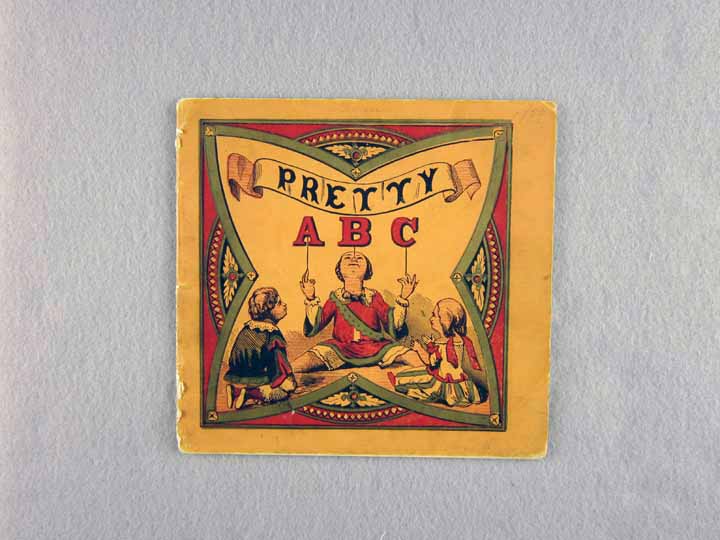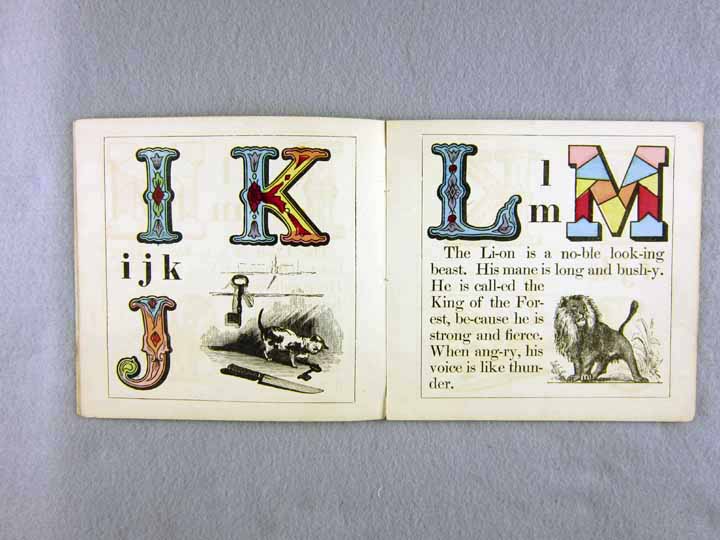

Alphabet books offer a vivid insight into the history of literacy and culture, as well as concepts of childhood. The Children's Book Collection at UCLA contains a rich array of these materials, some well-worn and much-used, some still bright and fresh. Each is a gem of print production and graphical imagery from another time and place. Though the history of alphabet books continues to the present, this exhibit focuses on the works in our collections published between 1700 and 1900, including horn books, primers, works of didacticism and seriousness, whimsy and play.
2. A Jumble ABC
3. A Little Pretty Pocket-Book
4. A New Lottery Book of Birds And Beasts
5. A Pretty Play-Thing for Children of All Denominations
8. ABC of Objects for Home And School
10. ABC with Pictures & Verses
12. Alphabet Et Instruction Pour Les Enfans
16. Dolly's ABC Book
17. Flora's ABC
18. Home ABC
22. Hornbook C. 1700
23. Large Letters for the Little Ones
24. Little ABC Book
25. Little People: An Alphabet
26. Martin's Nursery Battledoor
27. Mother Goose ABC
28. My Darling's ABC
29. Orbis Sensualium Pictus Quadrilinguis
30. People of All Nations: A Useful Toy for Girl Or Boy
31. Picture Alphabet
32. Pretty ABC
33. Railway ABC
34. Rusher's Reading Made Most Easy
38. The Alphabet of Old Friends
40. The Amusing Alphabet for Young Children Beginning To Read
42. The Child's Christian Education
45. The Easter Gift
47. The Favorite Alphabet for the Nursery
49. The Franklin Alphabet And Primer
51. The Golden ABC
55. The Moral And Entertaining Alphabet
57. The Old Testament Alphabet
59. The Picture Alphabet for Little Children
62. The Sunday ABC
63. The Union ABC
64. The Young Child's ABC, Or, First Book
65. Tom Thumb's Alphabet: Picture Baby-Books
67. Warne's Alphabet And Word Book: with Coloured Pictures
68. Wood's Royal Nursery Alphabet
Title Pretty ABC


Brief description Orange stiff wrappers, printed in black, red, and olive grin. First and last leaves pasted down to wrappers. Inscription in pencil on first leaf: George Laskrow from Mama, 1875. Wood engraved illustrations. Upper-case ornamental letters colored using stencil.
Full description The cover of Pretty ABC contains the title, with "Pretty" and "ABC" in two different fonts. The illustration on the cover is of a circus performer balancing the letters A, B, and C on sticks, while two children look on, enthralled. There is a decorative border around the illustration. The cover is printed on orange wrappers and is worn around the edges. There is some spine damage from wear. The text block of the book is sewn to the cover, and the bottom of the spine is splitting.
The book is twelve pages, consisting of colored uppercase letters and black and white illustrations for words starting with that letter. There are also occasional sentences that accompany the letters and illustrations. The letters are stencil-colored. Some letters do not have a sentence accompanying them, such as I, J, and K, and some letters do not have an image representing the letter, such as Q, X, Y, and C.
The book is printed so that there are two facing pages with illustrations and letters, followed by two blank pages. The book is not limited to illustrations of animals, although many of the pictures are. There are two styles of letters printed: blocky and florid. There is no author, illustrator, or publisher indicated, and there are no page numbers. There is an inscription on the edge of the inside front cover: "George Laskrow from Mama, 1875."
Literacy The Pretty ABC illustrates literacy in both the learning of letters and in the reading of simple sentences. Since the book is not just an alphabet, it would be intended more for children who have already learned their letters but are still in the beginning stages of learning to read. The learning of literacy is heavily aided by visual cues, matching recognizable images to letters.
One unique aspect of Pretty ABC is that the words in the sentences are short words broken down into syllables, making it easier for a child to read and comprehend both the sound and the word. Because the images are not all labeled, it adds an extra dimension to both literacy and visual literacy because it depicts images that children should know.
Childhood From the clown on the cover to the bright colors of the letters, to the illustrations, Pretty ABC shows childhood as a time of fun and learning. Although the exact printing date of this book is unknown, it was printed no later than 1875. Therefore it is likely that this book was published in the Victorian era where childhood was thought to be an idyllic time.
The book's depiction of mostly rural scenes highlights some aspects of Romantic notions, as well, particularly that of nature as teacher of virtue and beauty. Pretty ABC is not of particularly high production quality, and it is unlikely that children from wealthier families were the only intended audience.
Iconography There is no clear indication of the country of origin for Pretty ABC. Since the book is written in English, it was likely published in the United States or the United Kingdom. However, the images could depict either English or American life.
In general, the images in this book depict a rural environment. Many items depicted in this book, such as axes and dogs and donkeys, would be found in the countryside. This is in keeping with the Romantic ideals in the 1800s, where the idea that nature as teacher of "moral virtue and of beauty" were widespread.
The illustrations show children items that they should be - and likely were -familiar with. The only exceptions are the zebra and the lion, although the London Zoo was established in 1828 while the first zoo in the United States opened in 1859, making it plausible that a child might have seen these animals there. In the case of the lion, there is an explanation for what it is, and for the zebra there is an illustration showing the zebra in motion.
In contrast to the black and white realistic illustrations, the letters are all very elaborate and sometimes contain flourishes. The combination of pretty illustrations and bright colorful letters emphasize the concept of learning as fun. This fits in with the Victorian idea of childhood as an idyllic time.
Production There is no clear publication information for this book, such as a publisher or the location of where it was published. There is no author, illustrator, or distribution available. The estimated date of publication is no later than 1875, for the book bears an inscription that lists that year. The cover is orange stiff wrappers. Wrappers are the outer covering of a paperback book, and stiff wrappers are wrappers that are above average in thickness. The first and last leaves are pasted down to the wrappers. Throughout the book, the ink is black, red, and olive green, but the illustrations themselves are not colored.
Publisher Unknown
Publication place London
Date 1875
UCLA Call Number CBC PE1119 .P74 1875
Repository UCLA Charles E. Young Research Library, Dept. of Special Collections
Dimensions 18 cm
Technologies of production Stenciling, woodcut (process)
Additional Information Inscription: George Laskrow from Mama, 1875
Caption